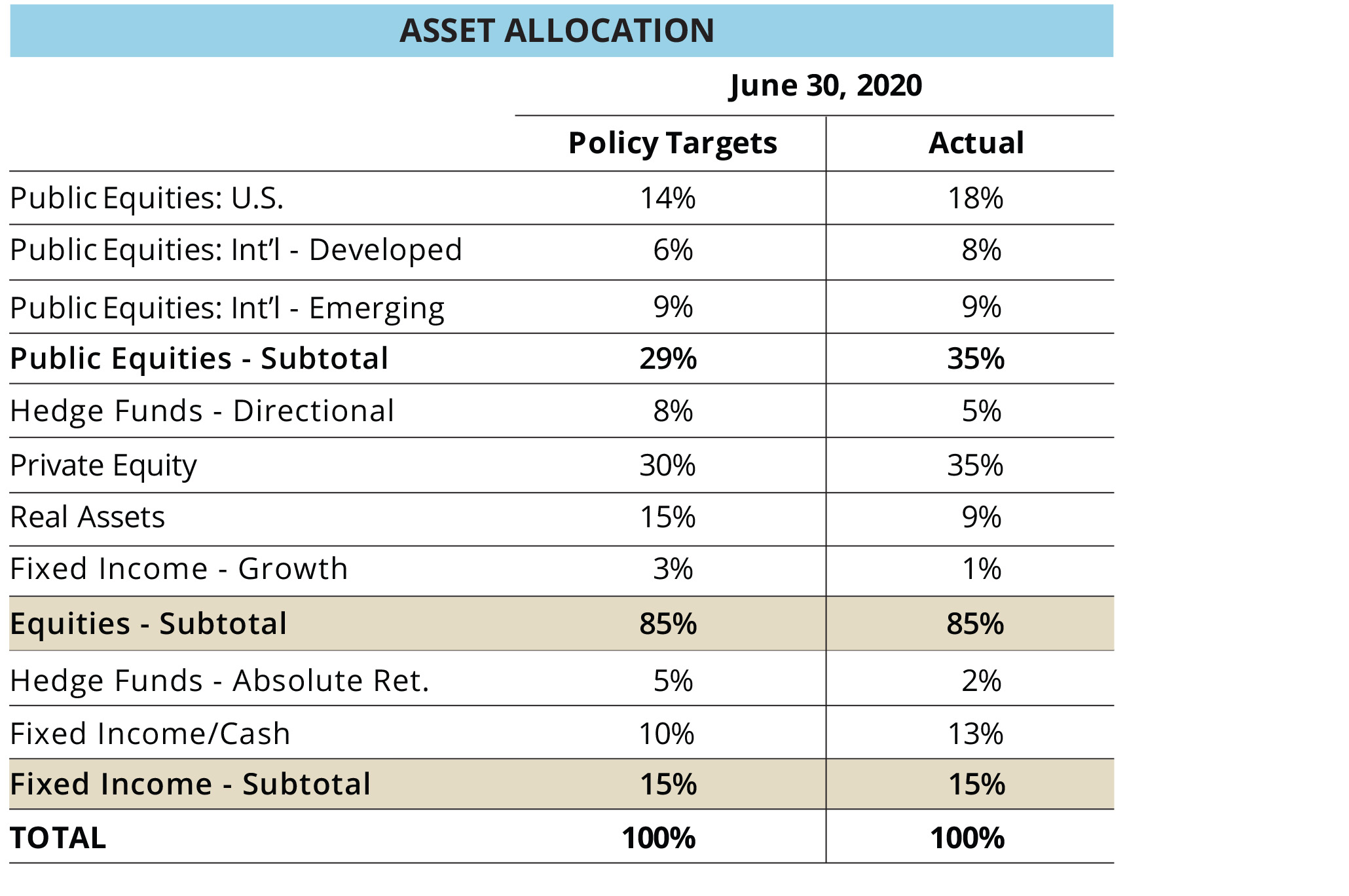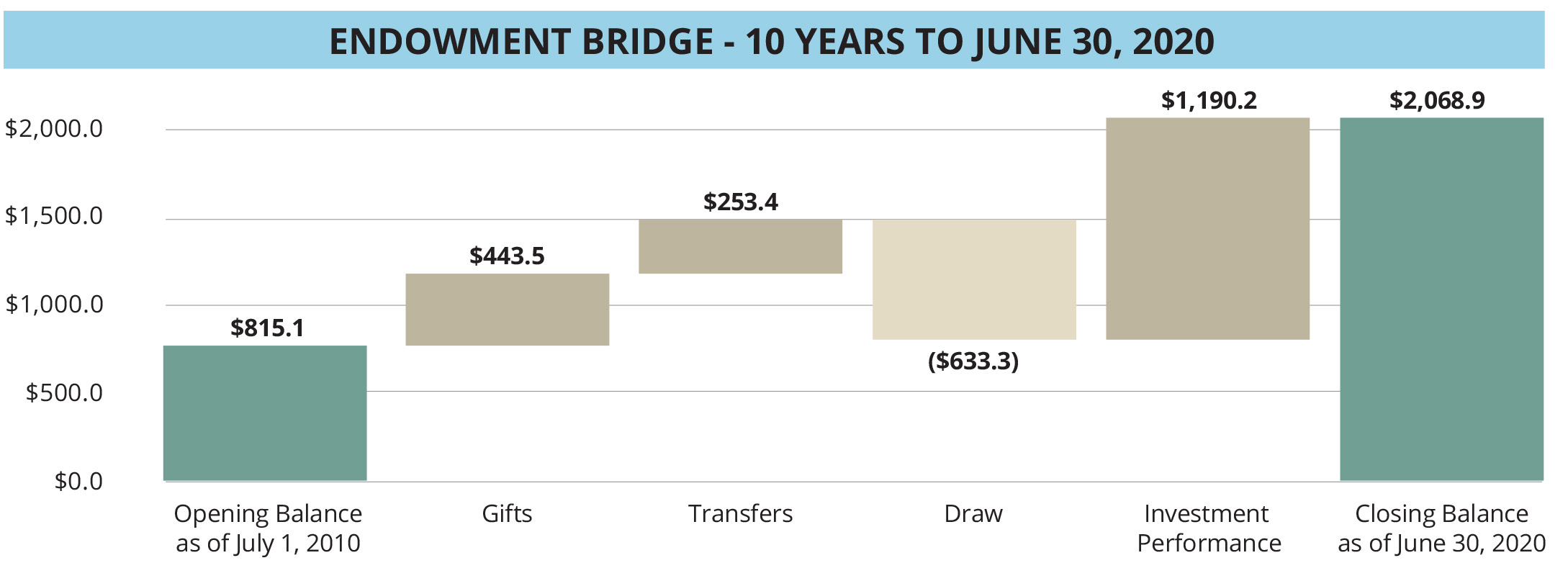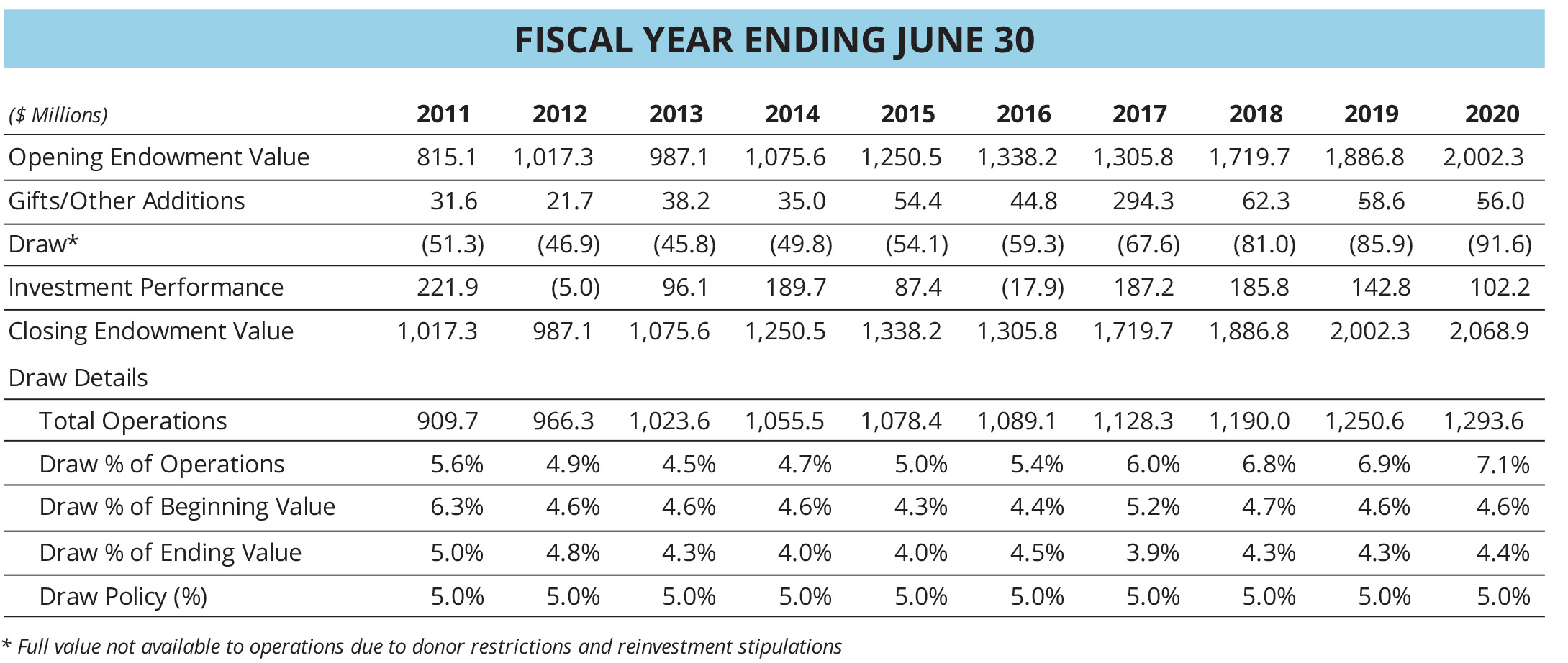Investment Highlights from Charles A. Kennedy, Chief Investment Officer
Overview
Built on a foundation of generous gifts and augmented by careful financial stewardship, Carnegie Mellon University’s endowment stood at a market value of $2.1 billion as of June 30, 2020. The endowment is an important strategic asset of the university. Carnegie Mellon seeks to advance knowledge and understanding in science and technology, fine arts and the humanities through its research and education mission. By providing a permanent and consistent source of funding for scholarships, professors’ salaries, laboratory equipment, etc., the endowment enables Carnegie Mellon’s faculty and student researchers to carry out the university’s mission. Critically, endowment support for tuition assistance attracts and retains a highly qualified and diverse student body. With its perpetual life, the endowment is uniquely situated to provide funding today and in the future to advance the university’s mission and to help Carnegie Mellon students and faculty achieve their goals and aspirations.
Each year, the Carnegie Mellon community confronts new challenges and pursues new opportunities. Fiscal Year 2020 (FY20) delivered ample doses of both challenge and opportunity as the university felt the impact of the novel coronavirus (COVID-19) pandemic. Coursework moved from in-person to remote, social distancing became the norm and Carnegie Mellon researchers honed in on improving pandemic response. Specific to the endowment, volatility spiked upwards. Investment values declined sharply in the March 2020 quarter followed by a rally by June 30, 2020. Carnegie Mellon’s response was to maintain long-term, strategic focus, rebalance to asset allocation targets and encourage our investment managers who can quickly react to changing market conditions to pursue opportunities as they saw best.
Strategy and Allocation
The endowment’s portfolio of investments is managed with a long-term, growth-oriented view and evaluated by its effectiveness in achieving — over time — two fundamental objectives: (1) generating steady and substantial financial support for students, faculty and programs; and (2) balancing current demands for support with the goal (at a minimum) of maintaining the endowment’s real purchasing power for future generations (i.e., preserving intergenerational equity). To maximize long-term expected returns within acceptable levels of risk and liquidity, Carnegie Mellon designed its policy asset allocation using a combination of academic theory, quantitative analysis and informed market judgment.
To achieve the objectives stated above, Carnegie Mellon targets broad portfolio exposure of 85% equities for long-term growth and appreciation, and 15% fixed income to provide stability and liquidity. FY20 marks the 16th anniversary of the university’s decision to shift equities focus from traditional, publicly traded investments to private investments, primarily utilizing private equity funds globally. We believe that over the long term, private equity investment returns, particularly from emerging markets, will exceed the returns available from investing in public securities, enabling the endowment to make larger contributions to the university mission.
Figure 1 details asset allocation targets and actual allocations as of June 30, 2020.
Figure 1: Asset Allocation – Policy Targets and Actual Allocations

As depicted in Figure 1, an over-allocation of 6% (compared to target) to public equities was offset by a similar under-allocation to directional hedge funds and private investments. This difference between policy targets and actual amounts is primarily due to a large cash influx to the endowment in Fiscal Year 2017 that was invested in public equities for capital appreciation pending reallocation of an appropriate share to new private investment opportunities to be identified and funded in coming years. At this 16th anniversary of the pursuit of the university’s long-term strategy, Carnegie Mellon’s private portfolio is maturing. However, due to the influx of new capital, achieving the private investments target, which was generally achieved in Fiscal Year 2016, will require several years of commitments, capital calls and the maturing of underlying investments. Fortunately, Carnegie Mellon’s endowment is of a size that permits new, reasonably sized commitments to value-creating investment managers that will be meaningful to the endowment’s asset allocation and investment return.
Investment Performance
The university’s net investment return for FY20 was 5.4%. More significantly, given the long-term goals of the investment strategy and the “noise” (versus signal) often associated with short-term equity results, Carnegie Mellon’s three-, five- and 10-year returns were 8.2%, 7.3% and 9.7%, respectively. These returns compare favorably with relevant benchmarks.
Endowment Attribution
The endowment’s market value increased to $2,068.9 million as of June 30, 2020, from $2,002.3 million as of June 30, 2019. This net increase of approximately $66.6 million reflects the collective impact of $56.0 million from gifts and other sources, plus $102.2 million from investment gains, less $91.6 million of distributions to support the university’s operations. As depicted in Figure 2, for the 10-year period ended June 30, 2020, the endowment’s market value increased approximately $1,253.8 million (from a beginning market value of $815.1 million), reflecting the collective impact of $696.9 million from gifts and other sources, plus $1,190.2 million from investment gains, less $633.3 million of distributions to support the university’s operations.
Figure 2: Endowment Bridge
(dollars in millions)

As previously noted, cash distributions from the endowment (i.e., the draw) provide a key source of support for various university activities and programs ranging from general operations to specific needs, such as scholarships and professorships. FY20 marks the seventh consecutive year in which endowment support as a percentage of the operating budget increased, starting with 4.5% of the university’s operations in Fiscal Year 2013 (FY13) and rising to 7.1% in FY20. This relatively higher level of support was achieved while the university’s operating expenditures grew. However, the endowment contribution to university operations is only about one-third that of other universities with endowments greater than $1 billion and even smaller when compared to a more select group of peer academic institutions. This relative position leaves Carnegie Mellon more dependent on tuition and sponsored research than its peers, reducing financial flexibility to pursue its long-term research and education mission.
This variance can be attributed to the relatively young life of Carnegie Mellon, which was created in 1967 through the merger of Carnegie Institute of Technology and Mellon Institute. During most of the university’s existence, financial resources donated by supporters have been focused more on capital infrastructure and current program needs than on long-term endowment savings. As a result, Carnegie Mellon’s endowment is significantly smaller — both in absolute terms and on a per-student basis — relative to peer academic institutions. This historical shortfall is being addressed through a greater focus on building the endowment over the long term through good stewardship and increased donor support from gifts to the university.
The historical activities of the endowment, including the draw and its support expressed as a percentage of annual operations, are summarized in Figure 3.
Figure 3: Endowment Values and Attribution

During the last decade, the draw from the endowment has contributed, on average, approximately 5.7% of the university’s annual operating budget. For FY20, the draw from the endowment provided 7.1% of the university’s operating budget. Viewed as a percentage of the annual budget, the relative support from the draw is affected not only by the growth in the endowment and the draw formula (see Note 7 on p. 21 of the consolidated financial statements), but also by the growth in the university’s annual operating budget, which increased by an average of 4.0% annually for the past decade.
The Dietrich Foundation
The Dietrich Foundation, established by Pittsburgh industrialist and longtime university trustee William S. Dietrich II, was created to manage in perpetuity his gift of approximately $500 million in assets intended to benefit the university and other higher education and charitable institutions. The Dietrich Foundation’s assets are not reflected in the university’s financial statements (see additional information regarding the foundation in Note 17 on p. 36 of the consolidated financial statements). The university’s share of the annual distributions from The Dietrich Foundation is 53.5%. If this percentage is applied to the estimated value of The Dietrich Foundation’s assets of $1,125 million as of June 30, 2020, and the result added to Carnegie Mellon’s endowment of $2,068.9 million, the combination would total $2,670.8 million. Annual distributions from The Dietrich Foundation over time equal 3% of the value of the foundation’s net assets as measured on January 1 of each year. The Dietrich Foundation’s gift added to Carnegie Mellon’s endowment for FY20 was $15.2 million, and cumulative gifts since the initial gift in FY13 total $94.1 million.
Summary
Carnegie Mellon’s endowment provides a permanent source of financial and operational stability, which helps university leadership to perpetuate academic and research excellence in a rapidly changing and increasingly competitive world. Enduring generosity of alumni and friends and an investment program focused on compounding net returns for the long term should continue to increase the value of Carnegie Mellon’s endowment over time, providing ongoing support for the university’s operating needs while preserving purchasing power to support future generations of students, faculty and programs.
Sincerely,

Charles A. Kennedy
Chief Investment Officer
October 16, 2020